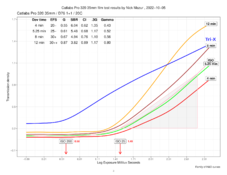In my haste, I forgot to include a plot comparing the curves of Catlabs 320 Pro and Kodak 400TX (purple). I gave Tri-X the same amount of exposure as the Catlabs 320 Pro (3.68 Log Millilux Seconds) and developed in the same tank for 8 minutes. Clearly, Tri-X did not receive enough development, as the contrast Index (CI) is only about 0.45. Even so, it presents a well-formed curve, with a fairly short "toe" and a long, monotonically increasing "straight line" portion of the curve. This would translate into a negative with a wide, smooth tonal range; one that should print easily on Grade 2 paper through a condenser enlarger (though I prefer to develop Tri-X to the CI of about 0.55). The speed point is about 3 stops "in front of" (or faster) than that of the Catlabs film of G=0.62 (the pink "ISO" curve and triangle). The Tri-X curve also shows much higher B+F density, which is to be expected as the film has a very different base and is a few years expired.
The manufactures of both films claim their respective products to be conventional, panchromatic, black and white films, with the "box speed" of around ISO 320-400. Both manufactures list D76 1+1 as a recommended developer. Catlabs lists 10 minutes at 20C (so that should translate to around 8:00 minutes in a rotary processor), whereas Kodak lists 9:45 minutes for 400TX in a rotary processor (again, my test sample did not receive enough development). Therefore, one would expect the curves to look very similar, except, of course, for the difference in base fog density and some other minor idiosyncrasies. As I mentioned earlier in the thread, the results suggest that, compared to Tri-X, the 320 Pro would have a much more "punchy" look, with significantly less shadow detail and a somewhat narrow, steep tonal range. I am sure it's a look that a lot of people love. It would require a softer paper grade to print well. A good scanner or DLSR, on the other hand, should be able to get some of the shadow detail back, with endless Photoshop editing possibilities.
Finally, while looking at each film through a magnifier, the Catlabs film appears to have somewhat finer grain than 400TX? Maybe? But that is just "by eye," so please take it with a grain of salt (pun not intended). My eyes are not what they used to be.
I am looking forward to seeing other people's tests of the Catlab 320 Pro and possible comparisons with other films.
View attachment 318180








